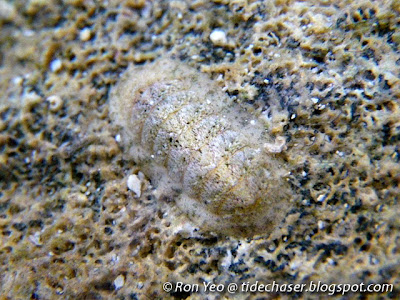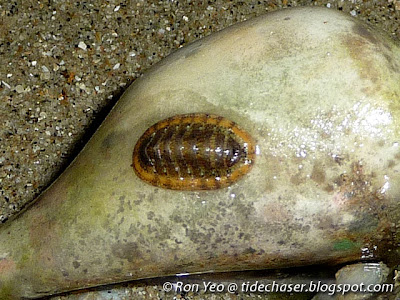A polyplacophoran (phylum Mollusca, class Polyplacophora), or chiton, is a soft-bodied animal with a shell made up of eight separate plates on its back, embedded in and surrounded by a leathery structure known as a girdle. The muscular girdle may be covered with scales or spicules, and usually has a somewhat oval outline.
The name "polyplacophora" means "to carry many tablets" - "poly" means "many" in Latin, "placo" means "tablet" in ancient Greek, while "phora" means "to carry, to bear" or "bearer".

Depending on the species, chitons can come in a variety of colours and patterns. Sometimes, the colours vary even between different chitons of the same species. The above is an unidentified chiton with a pinkish girdle and an intricately-patterned shell. It was about 3cm long.

Chitons have a muscular, oval to oblong foot on the underside, surround by the skirt-like girdle. The gills are located in the mantle cavity (the gap between the foot and the girdle). The head is located on the underside as well, separate from the foot. The mouth is located in the middle of the head.
Most chitons are slow moving and live on hard substrates. They mostly feed on algae or bryozoans, scraping them off with their radula (a tongue-like structure with rows of teeth on it).
Chitons reproduce sexually, and fertilisation is done externally. The males will release the sperm into the water, while the females will either release the eggs or get the sperm into their mantle cavity (with the currents generated as they breathe). Some species brood their young, while others lay egg strings.

Occasionally, some species of chitons can be seen congregating on the shells of dead marine snails on the shore. When disturbed, the chitons will clamp down tightly on the hard substrate. In the event when they are dislodged, they will roll up to protect the softer parts, exposing only their hard shells and tough girdles. They have special light-sensing organs (called aesthetes) embedded in their shells to sense danger. Some species are known to possess eye-like organs with a lens, retina and optical nerves.
In some countries, the bigger chiton species are collected for food.

The biggest chiton in Singapore is the Jewel Spiny Chiton (Acanthopleura gemmata), which can grow to more than 10cm long. Its girdle is covered with spikes, and it is sometimes found on rocks, sea walls and jetties nearer to the upper shore.
Most other chitons in Singapore are hard to identify in the field except for the experts, and hence apart from the species above, all the other featured chitons here are still awaiting identification.

This pinkish red chiton was found under a dead coral at the edge of a coral reef. It was about 2cm long.

This white chiton with black-bordered valves was seen under a rock on a rocky shore. It was about 1cm long.

This white chiton was seen on a dead coral in a coral reef. It was about 1cm long.

This orange chiton was about 0.5cm long. It was found on a lose rock on a sea wall.

This other orange chiton, not sure if it is of the same species as the previous one, was found on an empty shell.

This orange chiton, however, shared the shell with a hermit crab.

Some chitons can also be found on living shells, such as these two chitons, one orange and one green, on a White Hammer Oyster. These two chitons were very tiny, and not more than a few millimetres long.
References
The name "polyplacophora" means "to carry many tablets" - "poly" means "many" in Latin, "placo" means "tablet" in ancient Greek, while "phora" means "to carry, to bear" or "bearer".

Depending on the species, chitons can come in a variety of colours and patterns. Sometimes, the colours vary even between different chitons of the same species. The above is an unidentified chiton with a pinkish girdle and an intricately-patterned shell. It was about 3cm long.

Chitons have a muscular, oval to oblong foot on the underside, surround by the skirt-like girdle. The gills are located in the mantle cavity (the gap between the foot and the girdle). The head is located on the underside as well, separate from the foot. The mouth is located in the middle of the head.
Most chitons are slow moving and live on hard substrates. They mostly feed on algae or bryozoans, scraping them off with their radula (a tongue-like structure with rows of teeth on it).
Chitons reproduce sexually, and fertilisation is done externally. The males will release the sperm into the water, while the females will either release the eggs or get the sperm into their mantle cavity (with the currents generated as they breathe). Some species brood their young, while others lay egg strings.

Occasionally, some species of chitons can be seen congregating on the shells of dead marine snails on the shore. When disturbed, the chitons will clamp down tightly on the hard substrate. In the event when they are dislodged, they will roll up to protect the softer parts, exposing only their hard shells and tough girdles. They have special light-sensing organs (called aesthetes) embedded in their shells to sense danger. Some species are known to possess eye-like organs with a lens, retina and optical nerves.
In some countries, the bigger chiton species are collected for food.

The biggest chiton in Singapore is the Jewel Spiny Chiton (Acanthopleura gemmata), which can grow to more than 10cm long. Its girdle is covered with spikes, and it is sometimes found on rocks, sea walls and jetties nearer to the upper shore.
Most other chitons in Singapore are hard to identify in the field except for the experts, and hence apart from the species above, all the other featured chitons here are still awaiting identification.

This pinkish red chiton was found under a dead coral at the edge of a coral reef. It was about 2cm long.

This white chiton with black-bordered valves was seen under a rock on a rocky shore. It was about 1cm long.

This white chiton was seen on a dead coral in a coral reef. It was about 1cm long.

This orange chiton was about 0.5cm long. It was found on a lose rock on a sea wall.

This other orange chiton, not sure if it is of the same species as the previous one, was found on an empty shell.

This orange chiton, however, shared the shell with a hermit crab.

Some chitons can also be found on living shells, such as these two chitons, one orange and one green, on a White Hammer Oyster. These two chitons were very tiny, and not more than a few millimetres long.
References
- Coleman, N. 2003. 2002 Sea Shells. Neville Coleman’s Underwater Geographic: Springwood, Queensland. 144pp.
- Kuiter, R.H. and H. Debelius. 2009. World Atlas of Marine Fauna. IKAN-Unterwasserachiv. 723 pp.
- Oliver, A. P. H., 2012. Philip's guide to seashells of the world. Philip's, London. 320 pp.
- Rogers, J. E., 1908. The Shell Book - A Popular Guide to a Knowledge of the Families of Living Molluscs, and an Aid to the identification of Shells Native and Foreign. Charles T. Branford Co., Publishers. Boston, Massachusetts. 485 pp.
- Ruppert, E.E. and R.D. Barnes. 1991. Invertebrate Zoology (International Edition). Saunders College Publishing. U.S.A. 1056 pp.
- Tan, S. K. & H. P. M. Woo, 2010. A preliminary checklist of the molluscs of Singapore. Raffles Museum of Biodiversity Research, National University of Singapore, Singapore. 78 pp. Uploaded 02 June 2010.

No comments:
Post a Comment